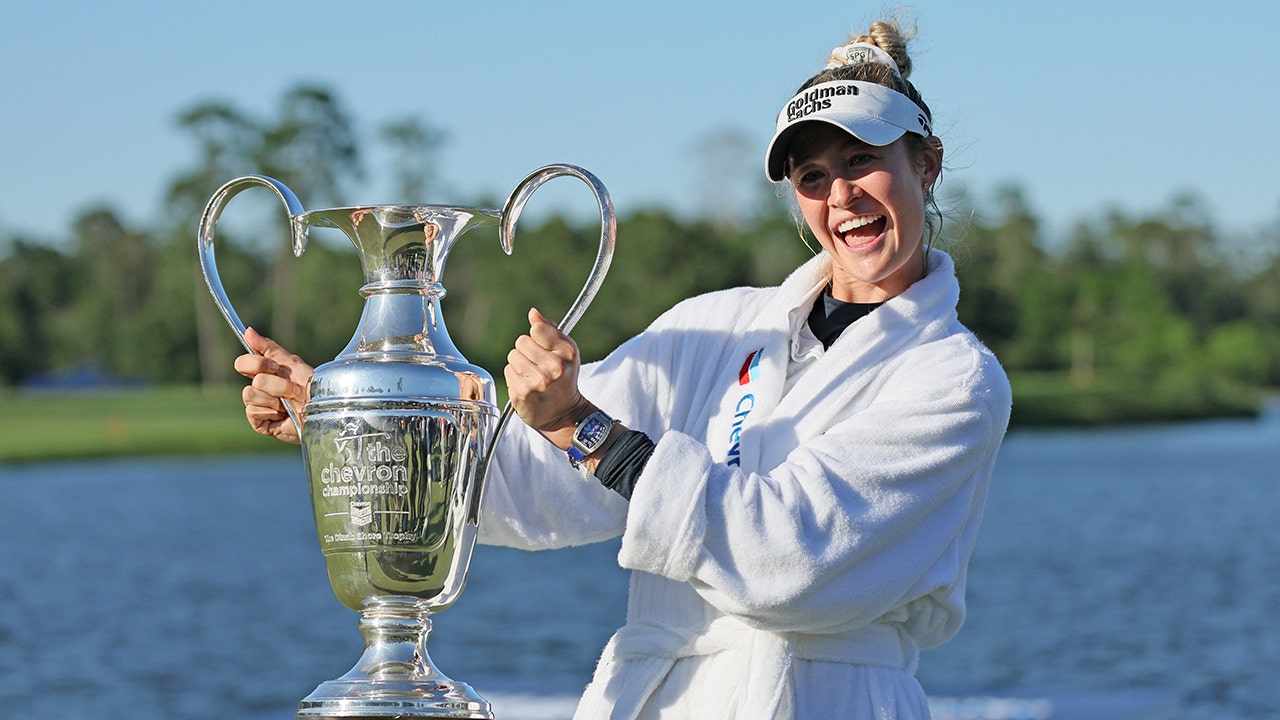BROOKSVILLE, Fla. — Not every great golf course lives forever. Even fewer of the very good ones do.
World Woods was a good bet to thrive when it opened in 1993, in the thick of one of the great golf booms in America, when the confluence of real estate development and suburban flight created an environment where a new golf course a day opened throughout the country.
With a Japanese businessman owner who held deep pockets, one of the biggest golf course designers of the generation working on two courses and a location within an hour of a growing Tampa, World Woods bore similarities to Bandon Dunes and even had advantages over the Oregon golf resort that also opened in the 1990s.
It all worked at World Woods — until it didn’t.
World Woods had every reason to be a smashing success in the golf industry, a bucket-list trip for future generations. People wait for hours on the phone to have a chance to book their Bandon trip a year in advance. By World Woods’ end, you could walk into the modest clubhouse and get a tee time.
Some three decades later, Cabot, one of North America’s largest golf resort companies — known for building jaw-dropping oceanside golf courses in exotic locales — has taken up ownership of the property, redeveloped it entirely and rechristened it Citrus Farms.
The result is a property that puts a smile on your face, centered around The Karoo, a Kyle Franz-designed course that widens your eyes at every tee box for its daring nature.
The actual golf was never the problem at World Woods. Tom Fazio, one of the distinguished architects of his generation, designed Pine Barrens and Rolling Woods, and did so to much acclaim — the site, an hour’s drive from Tampa, more resembled the South Carolina Lowcountry with its sandy, tree-lined fairways than Florida’s water hazard golf. By 1995, Golf Magazine declared Pine Barrens the 66th-best golf course in the world. Golf Digest considered it the ninth-best public upscale golf course in the United States.

The Wedge is 11 par-3 holes that are lit up to be played well into the night. (Courtesy of Carolina Pines Golf, Cabot Citrus Farms)
The problem was everything else, starting with the property being an hour from Tampa in an undeveloped part of Florida.
“We’re out here in the middle of the wilderness,” the head golf professional, Stan Cooke, told the St. Petersburg Times in 1993. “We’re going to have to bring in people from the outside.”
Japanese businessman Yukihisa Inoue’s plan to do that was with a golf academy, developing the next generation of professional golfers. And with a 120-room resort hotel, maybe even single-family homes and even more golf courses. With a membership primarily from Japan, with the rest from the United States. Sounds great, right? Except none of it happened. None of it.
A downturn in the Japanese economy is most often blamed for the lack of development, though for locals, the nationality of its ownership (at the same time, the Tampa Bay Lightning were also owned by a different Japanese businessman who didn’t always pay his bills) played some role in the palace intrigue.
Pine Barrens and Rolling Woods remained one great and one really good golf course, respectively, in the middle of nowhere, a small handmade sign on the highway the only evidence they existed. For a long time even that did not matter, the industry buzz enough to still fill the tee box with 60,000 rounds a year at its peak.
But then the late-2000s recession happened, and World Woods was hit as hard as anyone in the golf world. Then Streamsong opened between Tampa and Orlando, offering two (now three) top golf courses with an on-site hotel. Just like that, World Woods became fine. Still good. But easier and easier to get a tee time, a value rather than a destination. “It has great bones” was suddenly the way it was described, golf course aficionado parlance for a course that really should be better than it is.
Still, the course had its admirers, among them Ben Cowan-Dewar, CEO of burgeoning golf/real estate empire Cabot, who eventually convinced Inoue to sell the 2,000-plus acres to Cabot for its first North American property.
World Woods would not live forever. But it had a new chance and a new life.
This time it’s different. The rumble of heavy machinery and copious amounts of lumber can tell you that much. There are rows of cottages under construction, and Cabot says much of Phase 1 has sold out. On-property dining is also under development.
If you squint closely, with enough of a photographic memory, you can see what was. But with eyes wide, head on a swivel, you can see what is now.
The infrastructure to support the golf is much more than before, including the suburban creep from the Tampa metro area. But it must still be about the golf, and Cabot Citrus Farms is.
The Wedge is the 11-hole, par-3 course that’s lit up at night, inviting everything from an early morning walk to a late-night session with a beer in one hand and a 56-degree wedge in the other. The Squeeze is the companion to that experience, with nine holes that range from 100 yards to 550 yards. The Wedge and The Squeeze were designed by Mike Nuzzo, who also worked with Franz on Roost, a second 18-hole course expected to open to preview play this summer.

Karoo’s par-3 third hole plays over water, a rare hazard at Cabot Citrus Farms. (Courtesy of Paul Severn, Cabot Citrus Farms)
Short courses and alternative experiences to conventional golf may be all the rage these days in the golfing world, but they’re not going to be worth the trip. You need a full-length course that demands attention, and Karoo does that.
Occupying much of the land that Pine Barrens once did, Franz and his team first spent months taking the pines out of the equation. They lost count along the way but something around 6,000 trees, he estimates, were removed. The result is a wide-open property. Wind sweeps across the land. Waste areas dot the landscape. There’s very little water.
At its very best, Karoo is a rollicking good time, a big, bold rock opera of a golf course.
The first two holes get you going, but it really starts on No. 3, a par-3 with a direct carry line over water that plays at 292 from the tips and a much more manageable 224 from the tangerine tee box. Cabot considers it the toughest hole on the course, for good reason, but firsthand knowledge can confirm that even the average player can land on the green and have a good birdie look.
No. 4 is the first hole with two true paths to the green, a waste area running down the spine of the fairway. It’s a strategy Franz repeats several times along the way, culminating in his finishing hole, a beefy par 4 with a distinctive triple fairway that stretches 140 yards.
“What we started with there, it was a really, really tight dogleg left, where you have a lot of balls out in the forest, you will be lost, and there was just a really difficult finish. We made for a really cool adventure that is a fun ending to the golf,” Franz says.
The first and sixth holes share a green so large you can forget there’s another group on it, and No. 15 provides a counterbalance to that long par-3 No. 3 — it’s a par 4 that’s 388 from the back tees but 282 from the tangerine, playing downwind and giving you a chance to really go for it.
It’s all distinctive and a challenge to lose your ball. The latter gave Franz some freedom to really go for it with the green complexes, which will be some of the more undulating most golfers have ever seen.
“I’ve always wanted to do something that really celebrated the sort of wild unpredictable lawlessness of St. Andrews, like all the greens just kind of roll and flow across to those those great old ancient features, and within some cases, it’s a pretty mellow green and you can can a lot of putts. And you have something like the second green is like the craziest thing you’ve ever seen in golf, right?” Franz said.
“So we’ve tried to steal pieces of both. Like there’s some greens where it’s eminently possible to make a putt and make it from a long ways. And then we also have some really cool, zany kind of stuff out there.”
Resort golf tends to attract a wide spectrum of players. The very good golfers will see Karoo and identify the optimal landing areas and targets on the green in relation to pin positions and how Franz is challenging them. But the double-digit handicaps will not feel overwhelmed because it’s open enough to let them get around and allow them to try different shots.
And everyone can come together to enjoy The Wedge, which sits on a high point on the property and allows you to take in the remoteness of your surroundings at sunset. Turning a weakness into a strength and a flawed golf property into a potentially great one.
(Illustration: John Bradford / The Athletic; photos courtesy of Jeff K. Marsh, Cabot Citrus Farms)






